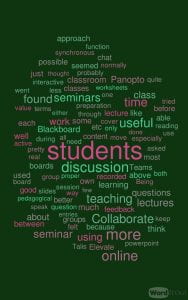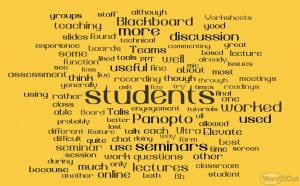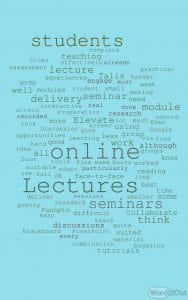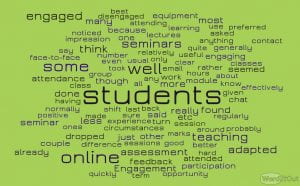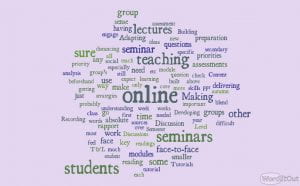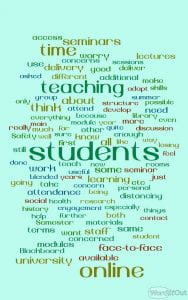In a Twitter post last week, I mentioned a survey that we conducted in the School of History and Heritage at the University of Lincoln of staff experiences of teaching in the lockdown context (i.e. a short turnaround move to 100% online delivery).
We also did a survey of staff (39 responses, which is A LOT), which I’ll share soon. Here’s a visualisation if responses to the question ‘briefly describe your experience of teaching post-lockdown’ #inclusiveHUK pic.twitter.com/bPS602wK5O
— Jamie Wood (@woodjamie99) June 3, 2020
As I said last week, many more responses came in from colleagues across the school than I had expected, from all subject areas and from temporary as well as permanent staff. Much of the feedback was institution-/department-specific, but much of it seems to resonate with accounts of experiences in the discipline (and sector) more broadly that I’ve seen over the past few weeks. So, I wanted to share a summary of the findings and my overall impressions. It was a fairly rough-and-ready survey, but has helped us to think about the challenges that we face in the next academic year.
Here are a few key points that emerged from the survey, with my musings:
- SUCCESSES. Many reported adapting successfully to the shift online, though not without some hiccups and usually involving A LOT of work. There was some innovative use of the tech that we’ve got available at Lincoln. We’re hoping to encourage those who had a good experience to write up case studies or do short presentations to share good practice. So, pretty positive overall.
- STUDENT ADAPTATION (OR NOT). There was a sense that students generally adapted well, if they were able to engage, including some who didn’t really get involved in F2F sessions; conversely, some who usually participated well in F2F teaching didn’t do so once teaching shifted online. Some of these instances related to issues of access (see below) and structure/ timetabling.
- SUPPORTING STUDENTS. Colleagues were concerned about the impact of the immediate shift (and perhaps longer-term changes to delivery patterns) on their ability to supporting struggling/ disengaged students.
- INDUCTION AND (RE)ORIENTATION. When asked about 2020-21 delivery, there was particular concern relating to the induction of new students (first years, but also new PG students). Beyond orientation, induction and socialisation, the issue of the reorientation of our existing students also loomed large.
- ACCESS. Access issues were reported for a significant number of students. This ranged from access to the necessary kit and wifi connection to physical workspace and time (when caring and/or family commitments may conflict with the university schedule).
- THE F2F FACE OFF. There was a clear tension between synchronous and asynchronous instruction. Although the colleagues that seem to have had the best experiences balanced these two modes of delivery (= blended learning), the survey results suggest that those technologies that best mapped against F2F delivery were generally favoured. Interestingly, the student survey seems to replicate these findings (though we’ve not yet finished analysing that), with students generally expressing a preference for tools like Panopto and Blackboard Collaborate Ultra, although some asynchronous tools such as Talis Elevate did receive positive comments.
- TIME. As you’ll see from the word clouds below, time seems to have been an issue because there was a swift turnaround to online delivery and the new modes of delivery seem to have been more time-consuming. There was also a sense that preparing and doing teaching in 2020-21 academic year would take up more time than usual.
Rather than walk you through each of the questions in detail (I don’t have time anyway!), I generated some word clouds, indicating frequency of responses to questions on the survey. I think these give a decent impression of the kinds of things that were on colleagues’ minds as the filled the survey in during the early part of May. I’ve added my own very brief summary of responses in italics after each question.
Describe your experience of the transition to online learning (briefly). stressful but successful (mostly)
Which approaches to online teaching and learning have you found most useful? whatever worked!
Which of these tools worked best for you? generally, ones that supported the efficient transmission of information to students (whether synchronous or asynchronous)
Which specific elements of your modules are best suited to online delivery? overwhelmingly, seminars and tasks that would be done in small group sessions (e.g. answering questions, preparing for assessments, socialising student groups)
How do you think that your students coped with the shift to online teaching, learning and assessment? well, in general, but there were problems
What are your absolute priorities if time for face-to-face teaching is limited at the start of the 2020-21 academic year? preparing for assessments, inducting and orientating students
What are your main concerns about the delivery of teaching in 2020-21? disengaged/ vulnerable students being left behind (+ a distant second, having enough time!)
Any comments (and questions) on this welcome – I’d be interested to know how it matches with experiences in other institutions.
As I said above, we’re currently looking through the student survey results (over 100 responses) and hope to be able to share some analysis in the next week or two.

